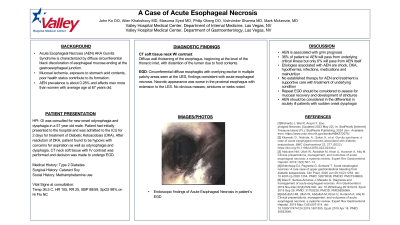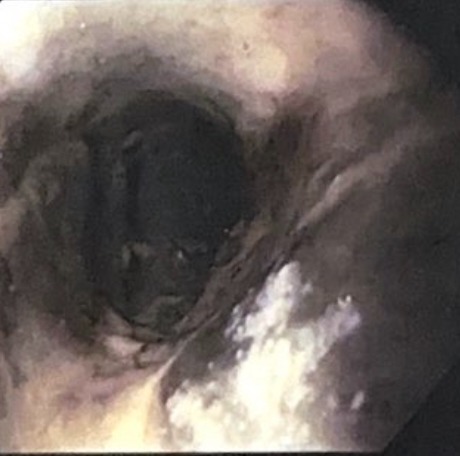Tuesday Poster Session
Category: Esophagus
P4030 - A Case of Acute Esophageal Necrosis
Tuesday, October 29, 2024
10:30 AM - 4:00 PM ET
Location: Exhibit Hall E

Has Audio

John Ko, DO
Valley Hospital Medical Center
Las Vegas, NV
Presenting Author(s)
John Ko, DO, Masuma Syed, MD, Allen Khakshooy, MD, Phillip Oberg, DO, Vishvinder Sharma, MD, Mark Mckenzie, MD
Valley Hospital Medical Center, Las Vegas, NV
Introduction: Acute Esophageal Necrosis (AEN) is a rare condition that is characterized by diffuse circumferential black discoloration of esophageal mucosa that ends at the gastroesophageal junction (GEJ). Multiple factors such as mucosal ischemia, esophageal mucosa exposure to stomach acid contents, and deterioration of the mucosal barrier due to poor health status contribute to its etiology. AEN prevalence is rare and estimated to be up to 0.28%. Men are more affected than women and the average age is 67 years old. We present a case of acute esophageal necrosis in a patient initially admitted for Diabetic Ketoacidosis (DKA).
Case Description/Methods: 57 year old male with type 2 diabetes, methamphetamine use was evaluated for acute onset dysphagia and odynophagia after initially presenting to our hospital for DKA. After treatment of his DKA, he was found to be hypoxic with concerns for aspiration. During his stay, his lab workup was notable for an elevated fungitell and the patient was started on Micafungin by Infectious Disease. CT neck soft tissue with IV contrast demonstrated diffuse wall thickening of the esophagus, beginning at level of thoracic inlet, with distention of lumen due to food contents. Given the CT findings and patient’s symptoms, EGD was performed and demonstrated circumferential diffuse esophagitis with overlying eschar in multiple patchy areas. The necrotic appearance was worse in the proximal esophagus and extended to the lower esophageal sphincter which was consistent with acute esophageal necrosis. The patient had a repeat EGD later in his hospitalization showing marked improvement.
Discussion: AEN portends to a grim prognosis. An estimated 36% of patients with AEN will pass due to their underlying critical illness but mortality from AEN itself is around 6%. Upper GI bleeding (UGB) is the most common presenting symptom in patients with AEN. Its etiologies include shock, DKA, hypothermia, infection, medications, and malnutrition. Our patient had DKA but was also being treated for a suspected fungal infection. He only reported dysphagia with no hematemesis or melena, both of which are the more common symptoms of AEN. There is no known established therapy for AEN and its treatment is supportive care with correction of the underlying condition. Repeat EGD should be considered to assess for mucosal recovery and screen for strictures. In conclusion, our case highlights the importance of considering AEN in the differential in acutely ill patients that develop sudden onset dysphagia.

Disclosures:
John Ko, DO, Masuma Syed, MD, Allen Khakshooy, MD, Phillip Oberg, DO, Vishvinder Sharma, MD, Mark Mckenzie, MD. P4030 - A Case of Acute Esophageal Necrosis, ACG 2024 Annual Scientific Meeting Abstracts. Philadelphia, PA: American College of Gastroenterology.
Valley Hospital Medical Center, Las Vegas, NV
Introduction: Acute Esophageal Necrosis (AEN) is a rare condition that is characterized by diffuse circumferential black discoloration of esophageal mucosa that ends at the gastroesophageal junction (GEJ). Multiple factors such as mucosal ischemia, esophageal mucosa exposure to stomach acid contents, and deterioration of the mucosal barrier due to poor health status contribute to its etiology. AEN prevalence is rare and estimated to be up to 0.28%. Men are more affected than women and the average age is 67 years old. We present a case of acute esophageal necrosis in a patient initially admitted for Diabetic Ketoacidosis (DKA).
Case Description/Methods: 57 year old male with type 2 diabetes, methamphetamine use was evaluated for acute onset dysphagia and odynophagia after initially presenting to our hospital for DKA. After treatment of his DKA, he was found to be hypoxic with concerns for aspiration. During his stay, his lab workup was notable for an elevated fungitell and the patient was started on Micafungin by Infectious Disease. CT neck soft tissue with IV contrast demonstrated diffuse wall thickening of the esophagus, beginning at level of thoracic inlet, with distention of lumen due to food contents. Given the CT findings and patient’s symptoms, EGD was performed and demonstrated circumferential diffuse esophagitis with overlying eschar in multiple patchy areas. The necrotic appearance was worse in the proximal esophagus and extended to the lower esophageal sphincter which was consistent with acute esophageal necrosis. The patient had a repeat EGD later in his hospitalization showing marked improvement.
Discussion: AEN portends to a grim prognosis. An estimated 36% of patients with AEN will pass due to their underlying critical illness but mortality from AEN itself is around 6%. Upper GI bleeding (UGB) is the most common presenting symptom in patients with AEN. Its etiologies include shock, DKA, hypothermia, infection, medications, and malnutrition. Our patient had DKA but was also being treated for a suspected fungal infection. He only reported dysphagia with no hematemesis or melena, both of which are the more common symptoms of AEN. There is no known established therapy for AEN and its treatment is supportive care with correction of the underlying condition. Repeat EGD should be considered to assess for mucosal recovery and screen for strictures. In conclusion, our case highlights the importance of considering AEN in the differential in acutely ill patients that develop sudden onset dysphagia.

Figure: Endoscopic finding of Acute necrosis of the esophagus
Disclosures:
John Ko indicated no relevant financial relationships.
Masuma Syed indicated no relevant financial relationships.
Allen Khakshooy indicated no relevant financial relationships.
Phillip Oberg indicated no relevant financial relationships.
Vishvinder Sharma indicated no relevant financial relationships.
Mark Mckenzie indicated no relevant financial relationships.
John Ko, DO, Masuma Syed, MD, Allen Khakshooy, MD, Phillip Oberg, DO, Vishvinder Sharma, MD, Mark Mckenzie, MD. P4030 - A Case of Acute Esophageal Necrosis, ACG 2024 Annual Scientific Meeting Abstracts. Philadelphia, PA: American College of Gastroenterology.
